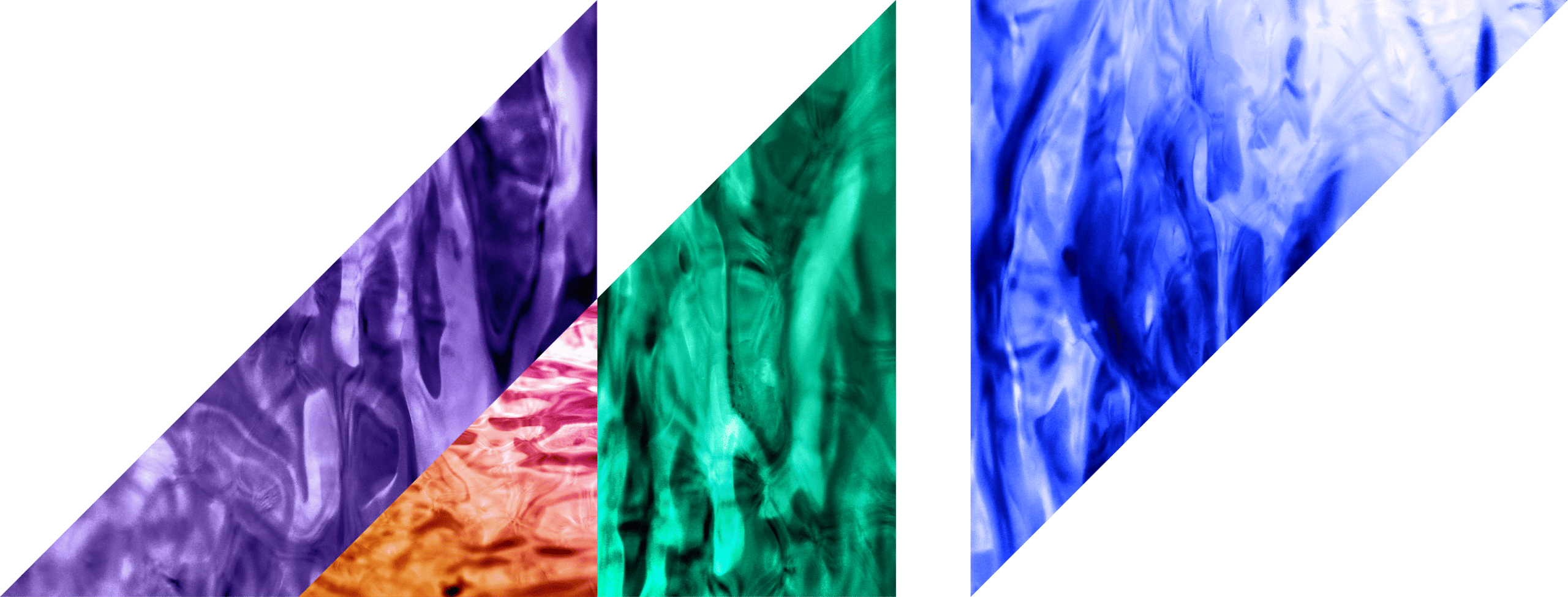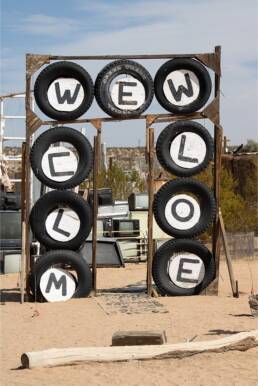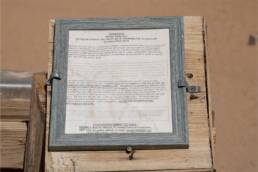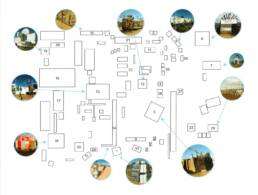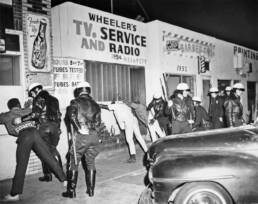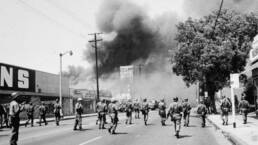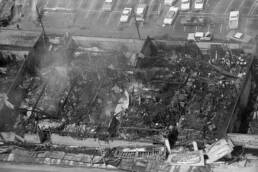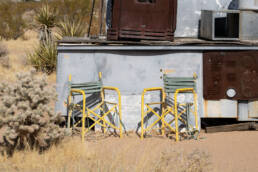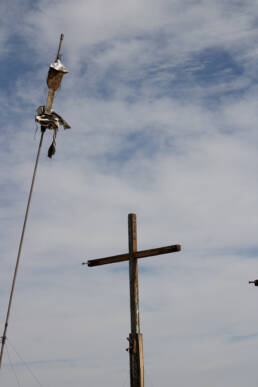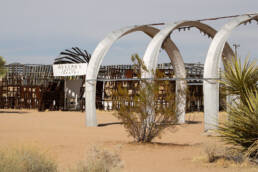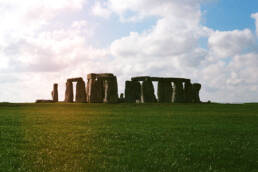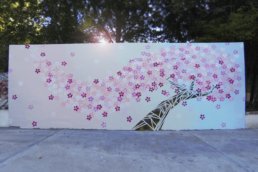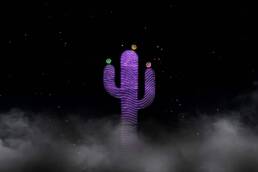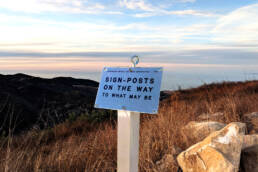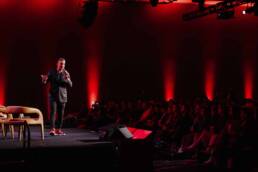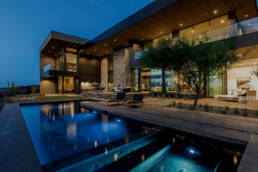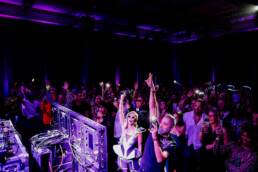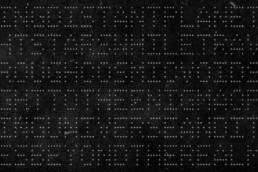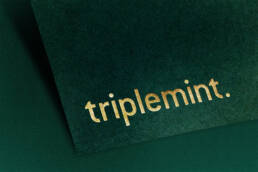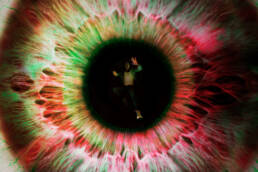NOAH PURIFOY.
NOAH PURIFOY.
In this write-up and collection of 35mm film photography, Purifoy’s Outdoor Desert Museum of Assemblage Sculpture in Joshua Tree, CA, is reviewed through the lens of socio-political issues that have persisted from the beginning of its creative development into the modern era.
WRITE-UP + PHOTOGRAPHY
Gallery Review + 35mm Film
The Outdoor Desert Museum of Assemblage Sculpture
“He described the openness of his museum as an unselfish act. There are no fences, and people don’t need to dress up and eat cheese and drink wine just to see art.”¹
Based in Joshua Tree, CA, Noah Purifoy’s Outdoor Desert Museum of Assemblage Sculpture “synthesizes the concerns of his life” and – very clearly – the milieu of concerns that many of us have (and will) maintain throughout life. From religion, ritual, and social policy to decoration, work, and play, each sculpture intimately addresses the innate qualities of the human condition. We see these subjects materialized in the form of their most prominent, modern symbols – wooden crucifixes with iron nails darted into the posts (sans the victims) stand 15 to 20 feet tall in the sand; old, box-shaped computers that have yellowed with age sit in a row within one structure modeled after an office; and stalls with the feet of “patrons” are tucked behind bushes, paint faded and wood splintered.
“Working freely with all kinds of materials and at every possible scale,” Purifoy developed a variety of sculptures across ten acres. Wood, glass, stone, rubber, iron, aluminum, ceramics, porcelain, paint, and plastic are only some of the materials Purifoy used to craft his sculptures. While some elements appeared to require meticulous construction – including oversized refrigerators coated with hardened, insulation foam – other sculptures (perhaps “scenes” is a better term) seem to have been pulled from trash collections, collaged together to form something new, often surreal in form but familiar in context.
Spanning across these ten acres, the outdoor museum has a number of entrances, but most visitors tend to begin at one of the most photo-worthy sights: an arch composed of several rubber tires, each painted with a letter of the word “welcome,” but organized to prevent the word from being read in any linear manner. Although there is a general path surrounding each sculpture, lined with pebbles and stones, you often find yourself wandering close to the assemblage, encouraged to enter and interact with many of the larger structures – one must of course be mindful of the crumbling infrastructure. Some sculptures are positioned independently in a given area, and others – such as a miniature train and railroad composed of aluminum piping and rusted shopping carts – weave in and out of larger installations.
To understand the circumstances surrounding why this museum was installed, one of the United States’ most tragic memories must be remembered. On August 11, 1965, Marquette Frye, a young African American motorist, was pulled over and arrested by Lee W. Minikus, a white California Highway Patrolman, for suspicion of driving while intoxicated. As a crowd of onlookers gathered at the scene of Frye’s arrest, strained tensions between police officers and the crowd erupted in a violent exchange.² Centered in the commercial section of Watts, a deeply impoverished African American neighborhood in South Central Los Angeles, the protesting and violence raged for six days and resulted in more than forty million dollars worth of property damage.³ The “Watts Riots,” as it would later be known, was both the largest and costliest urban rebellion of the Civil Rights era.⁴ A result of the community’s long-standing grievances and growing discontentment with high unemployment rates, substandard housing, and inadequate schools…rioters overturned and burned automobiles and looted and damaged grocery stores, liquor stores, department stores, and pawnshops.⁵
Over the course of the six-day riot, over 14,000 California National Guard troops were mobilized in South Los Angeles and a curfew zone encompassing over forty-five miles was established in an attempt to restore public order. All told, the rioting claimed the lives of thirty-four people, resulted in more than one thousand reported injuries, and almost four thousand arrests.⁶
Born in rural Alabama in 1917, Noah Purifoy moved to Birmingham when he was five, at a time when racism was a harsh and visible reality. He received a bachelor’s degree in social science from Alabama State Teacher’s College in Montgomery in 1939 and taught wood shop at a Tuscaloosa high school for the next three years. Purifoy then enlisted in the U.S. Navy and after his discharge in 1946 attended Atlanta University, receiving a master’s degree in social work in 1948.⁷
He moved to Los Angeles in 1950 and enrolled at Chouinard Art Institute (now CalArts) a year later, receiving a BFA in 1954. His training as a social worker and his own experiences growing up in the South led Purifoy to be committed as an artist to addressing the social and political concerns of the black community. He co-founded the Watts Towers Arts Center in 1964 [one year before the Watts Riots] with Judson Powell and Sue Welsh, serving as its first director. One of the first of its kind in California, the center provided opportunities in the arts for both artists and community residents.⁸
After the riots subsided, Purifoy took to the streets and collected debris, such as broken furniture and melted neon signs. He then channeled his anger and bitterness into a collaborative art piece. Working with artists from a variety of backgrounds, Purifoy used the Watts rubble to create 66 Signs of Neon, a symbolic and hopeful representation of change in an otherwise chaotic landscape.⁹
Purifoy explained, “We wanted to tell people that if something goes up in flames, it doesn’t mean its life is over.”¹⁰ Though 66 Signs of Neon achieved notoriety and traveled to nine universities between 1966 and 1968, it was only shown in student centers instead of traditional galleries. And while some critics have referred to Purifoy’s sculptures as helping to “redefine black consciousness in art,” his work, for the most part, has always remained outside the gallery walls.¹¹
According to Purifoy, it was the dramatic and harsh landscape of the Mojave that inspired him to create his assemblage pieces, which he referred to as “environmental sculpture.”¹²
In 1989 at the urging of his friend, artist Debby Brewer, whose family home and studio were in Joshua Tree, Purifoy moved his practice from Los Angeles to Brewer’s two-and-a-half-acre property in the high desert. At first, the setting felt foreign to him.¹³
In Noah’s own words: “I wasn’t sure I’d like the desert…because of the vast space and the Joshua trees, it just gives the impression of desolation and sheer poverty, actually. The earth is poor. It won’t bring forth green stuff. That’s what I miss most of all being here, since everything is brown here or beige or purple, as the case might be. But having lived here for a while…I’ve come to like it…I look up less often in anticipation. What that means is that when I was in L.A. as an artist, there were a lot of comings and goings, so every little noise I’d hear – As you know, most artists are extremely sensitive to noise, because they spend quiet times in their head…here in the desert, the rabbits, the birds, the scorpions, the lizards all run quiet.”¹⁴
Purifoy intended for his works to be displayed in their natural environment and process of decay. Resisting the ideologies of institutionalized art, Purifoy insisted, “I do assemblage. I don’t do maintenance…changes are an integral part of life itself.”¹⁵
Noah continued the development of the outdoor museum until his death in 2004, and his work continues to garner attention and interest from a broad array of university and independent scholars, critics, and artists.¹⁶
While Joshua Tree was an ideal place for Purifoy to create his work, the desert environment itself poses an ongoing threat to the sculptures. While Purifoy enjoyed how nature weathered and patinated his pieces, wind and weathering have also degraded many of the works so that they necessitate perpetual maintenance.¹⁷
In recent years, the Noah Purifoy Foundation – established in 1999 – has undertaken a sensitive refurbishment of several major works and organized annual events with community volunteers and fine artists.¹⁸
Purifoy’s work not only continues to comment upon issues of race, class, and culture, but also matters of conservation. With a work intended to decay over time, where does refurbishment draw the line? When one visits the outdoor exhibit, its deterioration is obvious and several sculptures are currently closed to the public due to safety concerns.
However, one could argue this was always Purifoy’s intent. What greater forms of art exist other than the natural cycles of life? And what is life without the assuredness of death? The exhibit is not simply defined by its spatiality or physiology, but additionally by its temporal qualities – what it was, and what it will be. In allowing decay – death – Purifoy grants the assemblage life.
If you visit the outdoor museum, you cannot see the exhibit for everything it is – only one face of an endlessly-sided object.
Bibliography
1. Harmatz, Jef. “High Art in Low Places: At Noah Purifoy’s Outdoor Desert Museum, Discarded Objects Get a New Purpose.” Roadtrippers, Togo Group, 30 Jan. 2020, roadtrippers.com/magazine/noah-purifoy-outdoor-museum-mojave-desert/.
2-6. “Watts Riots.” Civil Rights Digital Library, crdl.usg.edu/events/watts_riots/?Welcome.
7-8. Choi, Connie H. “Noah Purifoy.” Hammer Museum, hammer.ucla.edu/now-dig-this/artists/noah-purifoy.
9-10, 15. “The Noah Purifoy Desert Art Museum.” Atlas Obscura, Atlas Obscura, 13 Feb. 2010, www.atlasobscura.com/places/noah-purifoy-s-outdoor-desert-art-museum.
11-14, 16-18. “Noah Purifoy Outdoor Desert Art Museum of Assemblage Sculpture.” Art and the Landscape, The Cultural Landscape Foundation, tclf.org/sites/default/files/microsites/art-landscape/noah-purifoy.html.
